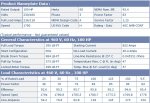Thank you all for your time. I find this site very useful I look forward to contributing what I know in the future.
At risk of repeating the other excellent answers, I see the basic problem here as your misuse, or perhaps misunderstanding, of terms.
FLA =
Full Load Amps. This is the amperes that the motor will draw when putting out FULL rated output, defined as rated torque at rated speed. HP is a shorthand way of describing a specific amount of torque at a specific speed. Motor HP is only a rating of what the motor is CAPABLE of.
When you are measuring current with whatever your load is, we refer to that as
RLA, or
Running Load Amps. This is the steady state amperes drawn by the motor to do the work of the load that it is attached to.
The amount of work the motor is called upon to perform is dictated by the attached load, not
what the motor is capable of, but limited
by the motor's rated capability. So a machine designer determines the maximum peak load, the speed the motor must spin, the torque it must put out, and that determines the shaft HP he needs from the motor. Then he selects a standard motor HP rating that is GREATER than the required shaft HP. That does not mean the motor WILL put out that much HP all of the time, but if called upon, it can. When you measure the RLA, you are looking at the current that the motor needs just to do that job.
Peaks are a fact of life, they are an inherent consideration in motor design and ratings etc. When you measure high peaks like the ones you mention, those are transients and not of immediate concern, as long as they happen in the right set of circumstances and in the right order. Most likely I would say that the 1300A reading you witnessed was an INITIAL inrush current, defined as what happens when you
first energize the motor windings. For a fraction of a second, the motor windings are essentially a short circuit until the magnetic fields are established. 10 - 13 times rated FLC is not uncommon, and in fact new energy efficient motors are often 17-20X. This is why you use "slow-blow" fuses on motor circuits. The 500A reading would be indicative of Starting Current or Locked Rotor Current (
LRC), the high current that takes place as the motor accelerates from a dead stop, and this can take several seconds. Totally normal, and in fact you can sometimes see LRC during operation if there is a high shock load. In the case of a compressor, this can sometimes happen when an "unload valve" closes. Compressors generally start unloaded, meaning the compression chamber is vented to air, because otherwise the motor may not start. Then several seconds later, the valve closes and there is a sudden pressure increase on the compressor, which may make the motor draw LRC again for an instant. Perfectly normal. But because at that point the motor windings are ALREADY magnetized, you should never see the full inrush current level, like your 1300A reading.
If you are absolutely sure that you saw 1300A
AFTER the 500A surge, then that would be indicative of a short circuit situation and cause for serious concern.


